Ceglie del Campo, sometimes simply Ceglie, is a quarter of Bari, the capital of Apulia, Italy. It is situated south of the city centre.
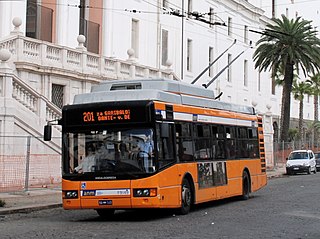
Trolleybuses in Naples provide a portion of the public transport service in the city and comune of Naples, in the region of Campania, southern Italy. From 1964 to 2015, two independent trolleybus systems were in operation, both publicly owned, but only that of Azienda Napoletana Mobilità (ANM) remains in operation. The ANM system opened in 1940, whereas the smaller trolleybus network of Compagnia Trasporti Pubblici di Napoli (CTP) opened in 1964.
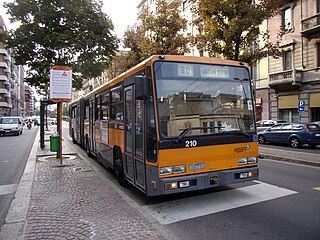
The Milan trolleybus system is part of the public transport network of Milan, Italy. In operation since 1933, the system presently comprises four routes. It is the second-oldest trolleybus system in Europe, after that of Lausanne, and the fifth-oldest in the world.
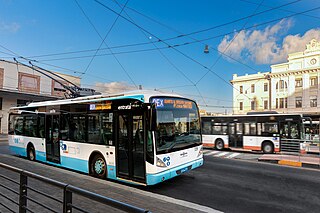
The Cagliari trolleybus system forms part of the public transport network of the city and comune of Cagliari and the Metropolitan City of Cagliari, in the region of Sardinia, Italy.

The Rome trolleybus system forms part of the public transport network of the city and comune of Rome, Italy. In operation since 2005, the current system comprises three routes.
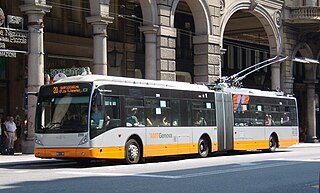
The Genoa trolleybus system forms part of the public transport network of the city and comune of Genoa, in the region of Liguria, northern Italy. In operation since 1997, the system currently comprises only one route. Between 2008 and 2012, two routes were being operated.

The Sanremo trolleybus system or San Remo trolleybus system, also known as the Italian Riviera trolleybus, is focused on the town and comune of Sanremo, in the region of Liguria, northwestern Italy.
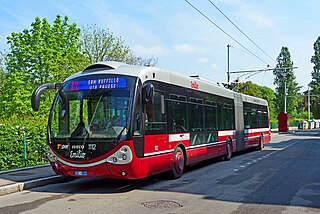
The Bologna trolleybus system is part of the public transport network of the city and comune of Bologna, in the region of Emilia-Romagna, northern Italy. While being in operation since 1991, the current system comprises five urban routes: 13, 14, 15, 32 and 33. Additional routes are presently under construction.
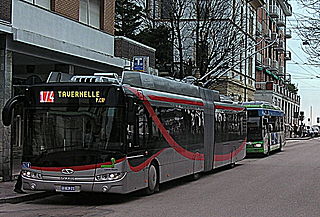
The Ancona trolleybus system forms part of the public transport network of the city and comune of Ancona, in the Marche region, central Italy. In operation since 1949, the system presently comprises only one urban route.

The Chieti trolleybus system forms part of the public transport network of the city and comune of Chieti, in the region of Abruzzo, central Italy. In operation since 2009, the system comprises one urban route.

The Modena trolleybus system forms part of the public transport network of the city and comune of Modena, in the region of Emilia-Romagna, northern Italy.

The La Spezia trolleybus system forms part of the public transport network of the city and comune of La Spezia, in the region of Liguria, northwest Italy.

The Rimini trolleybus system forms part of the public transport network of the Province of Rimini, in the region of Emilia-Romagna, Italy.

The Lecce trolleybus system forms part of the public transport network of the city and comune of Lecce, in the Apulia region, southern Italy.

The Fiat 2401 Cansa is an Italian trolleybus produced by Fiat.
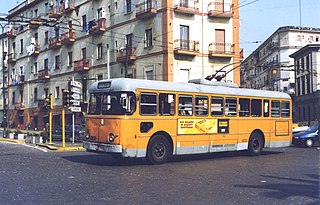
The Alfa Romeo Mille is a trolleybus manufactured by Alfa Romeo.

The Montreux/Vevey trolleybus system, also known as the Vevey–Villeneuve trolleybus line, forms part of the public transport network in Montreux and Vevey, in the canton of Vaud, Switzerland. It comprises a single 12.75 km (7.92 mi) long trolleybus route along the length of the Riviera vaudoise on the north shore of Lake Geneva.

The Avellino trolleybus system forms part of the public transport network of the city of Avellino and the province of Avellino, in the region of Campania. Trolleybuses originally served the city from 1947 to 1973, on a route that also extended outside the city to the neighbouring towns of Atripalda and Mercogliano, and then the system closed. However, in the 2000s work to build a new trolleybus system got under way and new vehicles were purchased for it in 2007, and were delivered in 2014. The project experienced several delays after the start of construction in 2009, but most issues had been resolved by 2020 and construction was largely completed by 2021. Throughout its planning and construction, it was inaccurately referred to as the "metropolitana leggera", when in fact it was never planned to be a rail line, and always planned to be a trolleybus line. The last round of testing took place in December 2022 and January 2023. The new trolleybus system opened for service on 3 April 2023, but service was suspended only three months later and is not expected to resume until 2026.

The Bari trolleybus system formed part of the public transport network of the city of Bari and the province of Bari, in the region of Apulia, Italy. Trolleybuses served the city from 1939 to 1987, on a network of several routes.























